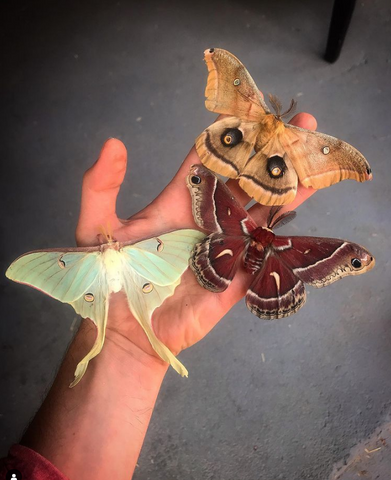The Fleeting Beauty of the Luna Moth
Thank you to our guest blogger Nathan Berry! Nathan is a 27 year old University of Washington biologist and published Lepidopterist who runs @Nateture.Nate, a popular wildlife instagram. You can find Nate on weekends running, birdwatching and taking nature photos in the wilds of North Carolina.

"The Fleeting Beauty of the Luna Moth"
Is there any animal more underrated than a moth? The way most people talk about them is typically with disgust or dread. And yet their extremely close relatives, the butterflies get nothing but praise and love. All one has to do is look at the beautiful family of moths known as Saturnidae (see pic below) to see that butterflies aren’t the only ones with absolutely gorgeous art and color in their wings. And although the flashy, day flying butterflies first caught my eye, there was an inescapable allure and beauty associated with moths, particularly silk moths. Queen among them being the gorgeous neon green Luna Moth Actias luna. (see the green moth on the left in the photo below)

If you are not familiar, Luna Moths are native to the American Southeast. I have been captive breeding large moths since I was a child, but raising Luna Moths is a real labor of love and a year long process! I start with the eggs, which hatch in May. The caterpillars start out very small and eat their way out of the egg. From there I must become very proficient at finding their host plants because once they reach full size they eat like cows! It's estimated that in TWO WEEKS, the caterpillar will be 3,000 times larger than the day it hatches! Eating and growing voraciously they can double in size every couple of days! The caterpillars shed their exoskeleton (or molt) as they grow. Each time expanding their exoskeleton to new heights. When the caterpillar is fully grown, it will find a suitable place to make it’s cocoon. It makes its cocoon out of silk which it spins from its mouth. Once this cocoon is made the caterpillar undergoes an amazing transformation. The caterpillar molts and forms the pupa which has the indentations of legs and wings and the adult antennae. The cells within the pupa undergo a process where they de-differentiate and the whole caterpillar essentially turns into goo! Then these cells reform into the longer, furry legs of a moth and tiny wingbuds. This is the most stressful part for me. The cocoon must go through a winter “diapause” or rest. This cocoon period lasts from August/September through March/April. This diapause can be as long as 9 months and is a harrowing time for me as I have to just patiently wait and hope they all survive and don’t get eaten by neighborhood squirrels.
Then, on the second week of April, I bring the cocoons in from outside (or from the fridge if I want to store them somewhere a little safer than the outdoor elements) and let them warm up. After about 2-4 weeks of warming up, these moths emerge from their pupa. To break out of their cocoons, the moth uses a bit of digestive acid to eat through the silk and then it climbs its way out. From their it crawls up a branch and starts to unfurl its wings by pumping them full of blood (insect blood is called hemolymph). This process takes a couple hours and then the wings must dry and the moth’s exoskeleton must harden over the next 24 hours. Females are heavier than males, as they are full of eggs. They typically are a little worse at flying so they climb to a tall post and release pheromones to entice a male to find her. The lighter, flightier males detect these pheromone chemicals with their large fuzzy antennae. These antennae are so sensitive that males can detect a female even 5 miles away! The moths fly for 2 weeks and only live to mate, lay eggs and die. They have no mouth parts and thus only survive on the fat they stored as a caterpillar. As they fly their large wings get slowly tattered. Amazingly they can fly even with 25% of their wings missing. I will often allow the moths to fly free in a large tent and I collect their eggs to start the process again! The eggs hatch about a month after being laid.

The Luna has become a symbol of the southeast, and many bands, drug companies, and artists use their image to represent the natural world, nighttime, sleep or the quiet country. It seems I am not the only one to be captivated by their beauty. You may be asking why I would go through 3 months of feeding and 9 months of waiting just to see the moths for only a couple weeks a year. All I can tell you is that the beauty of the Luna Moth is so alluring that the hard work and anticipation makes it all the more worthwhile when their beautiful green wings emerge. Maybe their brevity and the rarity of their existence makes them even more beautiful.
-Nate Berry

